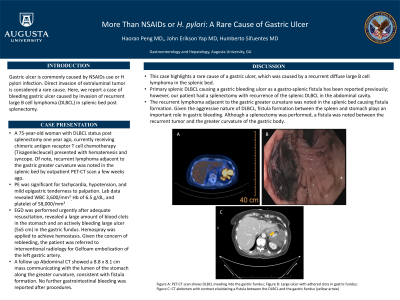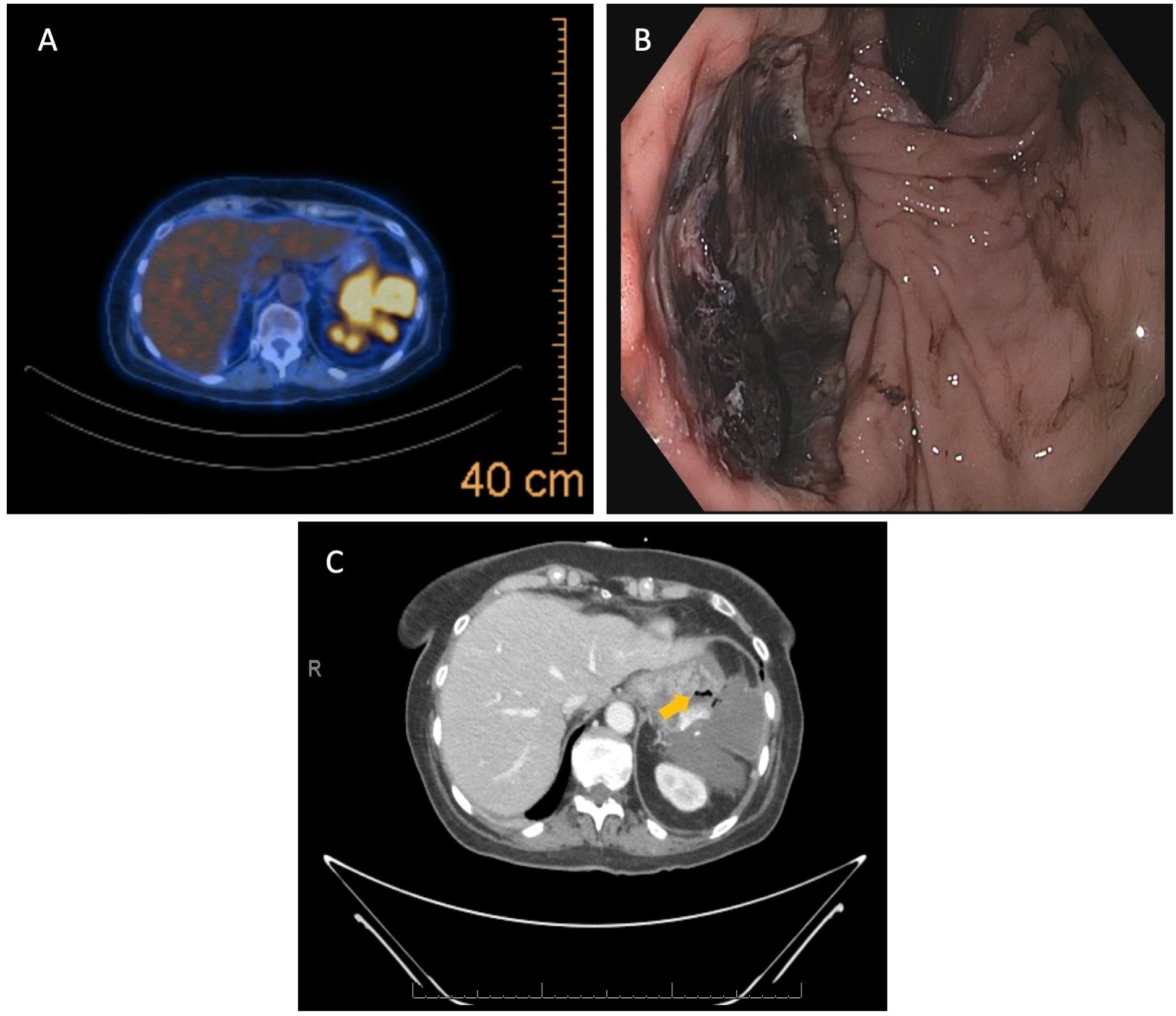Back


Poster Session A - Sunday Afternoon
Category: GI Bleeding
A0320 - More Than NSAIDs or H. pylori: A Rare Cause of Gastric Ulcer
Sunday, October 23, 2022
5:00 PM – 7:00 PM ET
Location: Crown Ballroom

Has Audio

Haoran Peng, MD
Augusta University Medical College of Georgia
Augusta, GA
Presenting Author(s)
Haoran Peng, MD1, John Erikson L. Yap, MD2, Humberto Sifuentes, MD1
1Augusta University Medical College of Georgia, Augusta, GA; 2Augusta University Medical College of Georiga, Augusta, GA
Introduction: Gastric ulcer is commonly caused by NSAIDs use or H pylori infection. Direct invasion of extraluminal tumor is considered a rare cause. Here, we report a case of bleeding gastric ulcer caused by invasion of recurrent large B cell lymphoma (DLBCL) in splenic bed post splenectomy.
Case Description/Methods: A 75-year-old woman with diffuse large B cell lymphoma (DLBCL) status post splenectomy one year ago, currently receiving chimeric antigen receptor T cell chemotherapy (Tisagenlecleucel) presented with hematemesis and syncope. Of note, recurrent lymphoma adjacent to the gastric greater curvature was noted in the splenic bed on the follow-up positron emission tomography-computed tomography a few weeks ago (Figure).
Physical examination was significant for tachycardia, hypotension, and mild epigastric tenderness to palpation.
Laboratory data revealed a white blood cell of 3,600/mm3 (reference range: 4,500-11,000/mm3), hemoglobin of 6.5 g/dL (reference range: 12-16 g/dL), and platelet of 58,000/mm3 (reference range: 150,000-400,000/mm3).
The patient received intravenous proton pump inhibitor drip and packed red blood cell transfusion. Esophagogastroduodenoscopy (EGD) was performed urgently after adequate resuscitation, which revealed a large amount of blood clots in the stomach and an actively bleeding large ulcer (5x5 cm) in the gastric fundus (Figure). Hemospray was applied to achieve hemostasis. Given the concern of rebleeding, the patient was referred to interventional radiology for Gelfoam embolization of the left gastric artery. A follow up Abdominal CT showed a 8.8 x 8.1 cm mass communicating with the lumen of the stomach along the greater curvature, consistent with fistula formation. No further gastrointestinal bleeding was reported after procedures.
Discussion: This case highlights a rare cause of a gastric ulcer, which was caused by a recurrent diffuse large B cell lymphoma in the splenic bed. Primary splenic DLBCL causing a gastric bleeding ulcer as a gastro-splenic fistula has been reported previously; however, our patient had a splenectomy with recurrence of the splenic DLBCL in the abdominal cavity. The recurrent lymphoma adjacent to the gastric greater curvature was noted in the splenic bed causing fistula formation. Given the aggressive nature of DLBCL, fistula formation between the spleen and stomach plays an important role in gastric bleeding. Although a splenectomy was performed, a fistula was noted between the recurrent tumor and the greater curvature of the gastric body.

Disclosures:
Haoran Peng, MD1, John Erikson L. Yap, MD2, Humberto Sifuentes, MD1. A0320 - More Than NSAIDs or H. pylori: A Rare Cause of Gastric Ulcer, ACG 2022 Annual Scientific Meeting Abstracts. Charlotte, NC: American College of Gastroenterology.
1Augusta University Medical College of Georgia, Augusta, GA; 2Augusta University Medical College of Georiga, Augusta, GA
Introduction: Gastric ulcer is commonly caused by NSAIDs use or H pylori infection. Direct invasion of extraluminal tumor is considered a rare cause. Here, we report a case of bleeding gastric ulcer caused by invasion of recurrent large B cell lymphoma (DLBCL) in splenic bed post splenectomy.
Case Description/Methods: A 75-year-old woman with diffuse large B cell lymphoma (DLBCL) status post splenectomy one year ago, currently receiving chimeric antigen receptor T cell chemotherapy (Tisagenlecleucel) presented with hematemesis and syncope. Of note, recurrent lymphoma adjacent to the gastric greater curvature was noted in the splenic bed on the follow-up positron emission tomography-computed tomography a few weeks ago (Figure).
Physical examination was significant for tachycardia, hypotension, and mild epigastric tenderness to palpation.
Laboratory data revealed a white blood cell of 3,600/mm3 (reference range: 4,500-11,000/mm3), hemoglobin of 6.5 g/dL (reference range: 12-16 g/dL), and platelet of 58,000/mm3 (reference range: 150,000-400,000/mm3).
The patient received intravenous proton pump inhibitor drip and packed red blood cell transfusion. Esophagogastroduodenoscopy (EGD) was performed urgently after adequate resuscitation, which revealed a large amount of blood clots in the stomach and an actively bleeding large ulcer (5x5 cm) in the gastric fundus (Figure). Hemospray was applied to achieve hemostasis. Given the concern of rebleeding, the patient was referred to interventional radiology for Gelfoam embolization of the left gastric artery. A follow up Abdominal CT showed a 8.8 x 8.1 cm mass communicating with the lumen of the stomach along the greater curvature, consistent with fistula formation. No further gastrointestinal bleeding was reported after procedures.
Discussion: This case highlights a rare cause of a gastric ulcer, which was caused by a recurrent diffuse large B cell lymphoma in the splenic bed. Primary splenic DLBCL causing a gastric bleeding ulcer as a gastro-splenic fistula has been reported previously; however, our patient had a splenectomy with recurrence of the splenic DLBCL in the abdominal cavity. The recurrent lymphoma adjacent to the gastric greater curvature was noted in the splenic bed causing fistula formation. Given the aggressive nature of DLBCL, fistula formation between the spleen and stomach plays an important role in gastric bleeding. Although a splenectomy was performed, a fistula was noted between the recurrent tumor and the greater curvature of the gastric body.

Figure: A: Positron emission tomography scan revealing invasion of DLBCL into the gastric fundus; B: Large ulcer with adhered clots in gastric fundus; C: Computerized tomography of abdomen with contrast elucidating a fistula between the DLBCL and the gastric fundus (yellow arrow)
Disclosures:
Haoran Peng indicated no relevant financial relationships.
John Erikson Yap indicated no relevant financial relationships.
Humberto Sifuentes indicated no relevant financial relationships.
Haoran Peng, MD1, John Erikson L. Yap, MD2, Humberto Sifuentes, MD1. A0320 - More Than NSAIDs or H. pylori: A Rare Cause of Gastric Ulcer, ACG 2022 Annual Scientific Meeting Abstracts. Charlotte, NC: American College of Gastroenterology.
